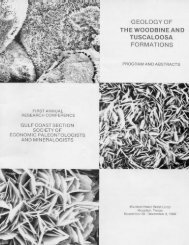Petroleum Systems of Deep-Water Basins - Gulf Coast Section SEPM
Petroleum Systems of Deep-Water Basins - Gulf Coast Section SEPM
Petroleum Systems of Deep-Water Basins - Gulf Coast Section SEPM
Create successful ePaper yourself
Turn your PDF publications into a flip-book with our unique Google optimized e-Paper software.
Thrust, Kinematics and Hydrocarbon Migration in the<br />
Middle Magdalena Basin, Colombia, South America<br />
Luisa Fernanda Rolón<br />
Department <strong>of</strong> Geology and Geography<br />
West Virginia University<br />
Morgantown, West Virginia<br />
e-mail: lrolon@geo.wvu.edu<br />
Juan Lorenzo<br />
Department <strong>of</strong> Geology and Geophysics<br />
Louisiana State University<br />
Baton Rouge, Louisiana<br />
e-mail: juan@geol.lsu.edu<br />
Allan Lowrie<br />
Consultant Geologist<br />
238 F.Z. Goss Road<br />
Picayune, Mississippi 39466<br />
e-mail: alowrie@webtv.net<br />
Darío Barrero<br />
La Luna Oil Company<br />
Calle 100 No. 8ª-55 Torre “C” Of. 504<br />
Bogotá,Colombia<br />
e-mail: dbarrero@uole.com<br />
Abstract<br />
<strong>Petroleum</strong> systems commonly develop in large sedimentary wedges. In Colombia, large sedimentary wedges exist<br />
along the Pacific active margin, along the Caribbean right-lateral transcurrent margin, and in the Middle Magdalena<br />
Valley basin. The Middle Magdalena basin Neogene sedimentary wedge gently laps onto the Precambrian/Lower<br />
Paleozoic metamorphic rocks <strong>of</strong> the west wall <strong>of</strong> the Middle Magdalena Valley basin, which is the Central Cordillera.<br />
The Central Cordillera is the northern extension <strong>of</strong> the Andean magmatic arc created by subduction <strong>of</strong> the Farallon/<br />
Cocos plates. This volcanic arc has been active, certainly during historic and present times.<br />
The end <strong>of</strong> Mesozoic-initiated subduction parallel to the Upper and Middle Magdalena Valley basins triggers the<br />
uplift <strong>of</strong> the Central and Eastern Cordilleras. The Eastern Cordillera, east <strong>of</strong> the Middle Magdalena Valley, displays<br />
abundant reflection seismic evidence <strong>of</strong> east to west thrusting involving Tertiary and Cretaceous valley sediments during<br />
Late Paleocene-Early Eocene, related to Central Cordillera uplift. Thrusting continues today to the west <strong>of</strong> the<br />
Eastern Cordillera, at a rate <strong>of</strong> several cm/year. Low-grade deformation associated with thrusting can nucleate folds<br />
and lead to fracturing having no lateral movement. Such deformation can create non-steady state complex fluid flow<br />
at various scales, by opening and closing migration routes through fracture networks. Higher-grade compressional<br />
deformation, such as shortening across the Middle Magdalena Valley associated with the Eastern Cordillera uplift,<br />
inverts former extensional features during the Paleocene and middle to late Miocene. This structural inversion is documented<br />
in oil fields within the basin such as La Cira-Infantas giant oil field.<br />
Uneven advance <strong>of</strong> the thrust and deformation front in a vertical and lateral sense adds greater complexity to<br />
regional shortening <strong>of</strong> the Middle Magdalena Valley basin. The advance <strong>of</strong> the eastern wall (Eastern Cordillera) <strong>of</strong> the<br />
Middle Magdalena Valley basin is not continuous. Portions <strong>of</strong> the eastern wall advance more rapidly than others as<br />
evidenced by the uneven and irregular spacing <strong>of</strong> Holocene faults. Irregular deformation rates seen on the surface may<br />
also apply to the subsurface. From a petroleum system perspective, a sedimentary body less deformed than its neighbors<br />
may retain its fluid longer. When local deformation finally occurs, it may be relatively rapid. Fluid expulsion<br />
then can be more energetic than in adjacent areas, and a second phase <strong>of</strong> hydrocarbon migration takes place.<br />
36

















